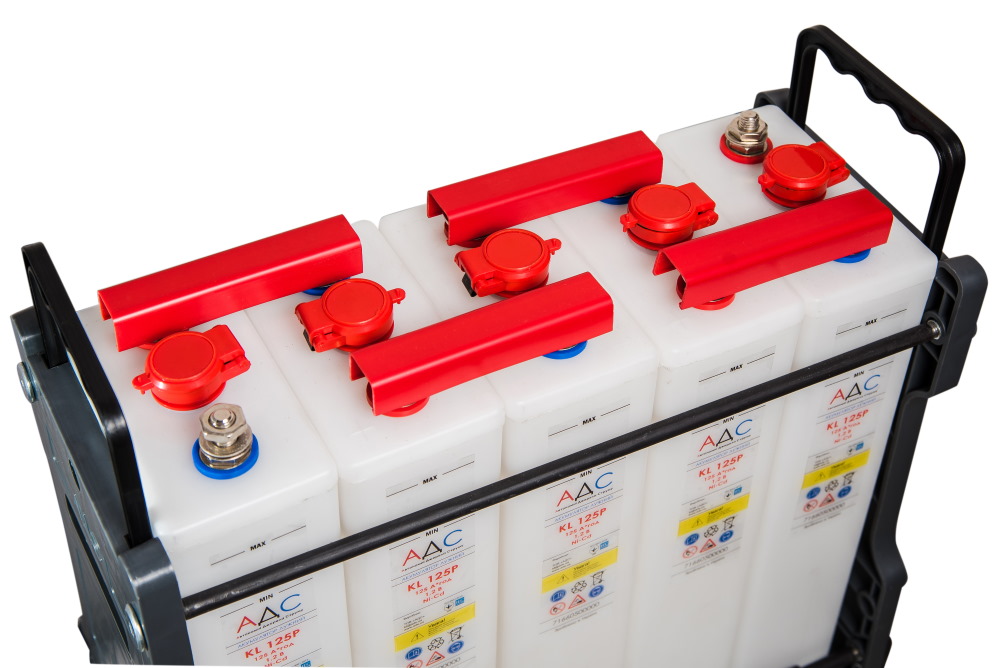Industrial batteries (traction) – they are sources of electrical energy, which are used to power various types of equipment with an electric drive, such as forklifts, electric cars, elevators, platforms, floor washing machines, etc. They differ from ordinary batteries in that, that can produce a large current for a long time, are not afraid of deep discharges and have a large number of charge-discharge cycles. You can buy industrial batteries here https://baterka.ua/product-category/promuslovi-akumulyatory/, and in this article we will consider their main characteristics, types, advantages and disadvantages, and we will also give advice on their selection, operation and maintenance. 
Characteristics of industrial batteries (traction)
Industrial batteries have a number of characteristics, which determine their performance, reliability and service life. The main ones are as follows:
- Capacity – is the amount of electric charge, which can accumulate battery. It is measured in ampere-hours (A g) or watt-hours (W g) and shows, how long the battery can power the equipment without recharging. The larger the capacity, the more energy reserve the battery has.
- High-voltage – is the potential difference between the two poles, measured in volts (AT) and shows, what electric field strength does the battery create. The greater the voltage, the more power the battery can produce.
- Current – is the amount of electric charge, which passes through the battery per unit of time. It is measured in amperes (BUT) and shows, what strength of electric current can the battery produce. The greater the current, the greater the speed of operation of the equipment can provide the battery.
- Type of – it is a chemical system, which is used to convert chemical energy into electrical energy and vice versa. It determines the composition, structure and principle of operation of the battery. The most common types of industrial batteries (traction) are lead-acid, nickel-cadmium, nickel metal hydride, lithium-ion and lithium-polymer. Each type has its advantages and disadvantages, which affect performance, safety and cost of the product.
- The number of charge-discharge cycles – this is the number of full or partial charging and discharging processes, that the battery can withstand, without losing its characteristics. This indicator reflects the length of service. The greater the number of cycles, the longer the battery can work without replacement.
Types of industrial batteries
By type of chemical system, industrial batteries (traction) can be divided into the following main groups:
- Lead-acid – these are the most common and cheapest batteries, which are used for traction purposes. They consist of plates of lead and lead dioxide, immersed in a solution of sulfuric acid. During charging, oxidation of lead occurs at the anode and reduction of lead dioxide at the cathode. During discharge, the processes take place in the opposite direction. Lead-acid batteries have a high capacity, resistance to deep discharges and low cost. However, they also have a low energy density, great weight, require regular maintenance and are harmful to the environment.
- Nickel-cadmium – these are batteries, which use nickel hydroxide as the cathode and cadmium as the anode. The electrolyte is a solution of potassium hydroxide. During charging, cadmium is oxidized at the anode and nickel hydroxide is reduced at the cathode. During discharge, the processes take place in the opposite direction. Nickel-cadmium batteries have a high energy density, resistance to deep discharges and a large number of charge-discharge cycles. However, they also have low capacity, high self-discharge, require regular recharging and are harmful to the environment due to the cadmium content.
- Nickel metal hydride – these are batteries, which use nickel hydroxide as the cathode and metal alloy, which can absorb hydrogen, as an anode. The electrolyte is a solution of potassium hydroxide. During charging, hydrogen is oxidized at the anode and nickel hydroxide is reduced at the cathode. During discharge, the processes take place in the opposite direction. Nickel metal hydride batteries have a higher capacity, energy density and number of charge-discharge cycles, than nickel-cadmium. However, they also have high self-discharge, require regular recharging and are more expensive than nickel-cadmium.
- Lithium-ion – these are batteries, which use lithium salts as the cathode and carbon material as the anode. The electrolyte is an organic solution with dissolved lithium salts. During charging, lithium ions are transferred from the cathode to the anode. During discharge, the processes take place in the opposite direction. Lithium-ion batteries have the highest energy density, capacity and number of charge-discharge cycles, than other types of batteries. However, they also come at a high cost, requirements for temperature and voltage control, prone to fire and explosion when damaged or overcharged.
- Lithium-polymer – these are batteries, which use lithium salts as the cathode and carbon material as the anode. The electrolyte is a polymer solution with dissolved lithium salts. During charging, lithium ions are transferred from the cathode to the anode. During discharge, the processes take place in the opposite direction. Lithium-polymer batteries have similar characteristics, as lithium-ion, but differ in that, which have a more flexible and thin shape, less weight and safer.
Advantages and disadvantages of traction batteries
Traction batteries have their advantages and disadvantages, which should be taken into account when choosing them, operation and maintenance. The main ones are as follows:
- Advantages:
- They provide autonomous power supply for equipment with an electric drive, regardless of the availability of the power supply network.
- They have high energy conversion efficiency, reaching 80-90%.
- They have a large number of charge-discharge cycles, reaching 1000-2000 times.
- They have a low level of noise and vibration, do not emit harmful substances into the air.
- They have a long service life, reaching 5-10 years.
- Disadvantages:
- They have a high cost, especially lithium-ion and lithium-polymer batteries.
- They have a large weight and dimensions, especially lead-acid batteries.
- They have high self-discharge, especially nickel-cadmium and nickel-metal hydride batteries.
- Require regular recharging, maintenance and condition control.
- Prone to fire and explosion in case of fire and explosion in case of damage, overcharging or overheating, especially lithium-ion and lithium-polymer batteries.
- They have a limited resource, which decreases over time and depends on operating conditions.
Tips for choosing, operation and maintenance of industrial batteries (traction)
When choosing industrial batteries (traction) the following factors should be considered:
- Type of equipment, which must be powered by a battery, and its power, High-voltage, current and operating time.
- Budget, which you are willing to spend and its compliance with the quality and characteristics of the battery.
- Terms of use, such as temperature, humidity, vibration, external influences.
- Infrastructure availability for charging and maintenance, such as chargers, service centers, spare parts.
The following tips should be followed when operating and servicing industrial traction batteries:
- Charge the battery only with a suitable charger, which matches the type, voltage and current.
- Do not allow deep discharge below 20% from its nominal capacity, as this may result in reduced battery life.
- Do not leave the battery without charging for a long time, as this can lead to increased self-discharge and sulfation of plates.
- Do not use the battery in high or low temperatures, as this may result in reduced capacity, energy density and service life.
- Do not subject the battery to mechanical damage, blows, I broke it, short circuit, as it may cause fire or explosion.
- Regularly check the condition of the battery, such as voltage, capacity, electrolyte level, appearance, and correct detected malfunctions in a timely manner.
When used correctly, industrial batteries (traction) can provide high productivity, reliability and service life of equipment, and also reduce fuel costs and environmental pollution. You can buy everything you need for battery maintenance here https://baterka.ua/product-category/aksesuary-do-akumulyatoriv/, in the Ваterka online store.










